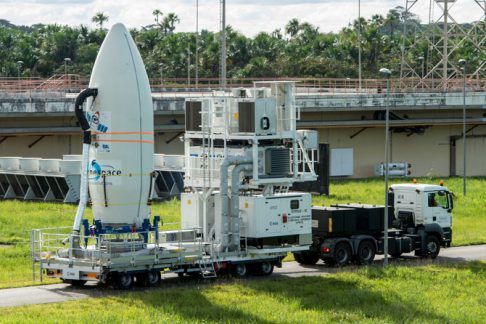18.07.2017
Vega is prepared for the twin Earth observation payloads to be orbited on Arianespace’s August 1 mission
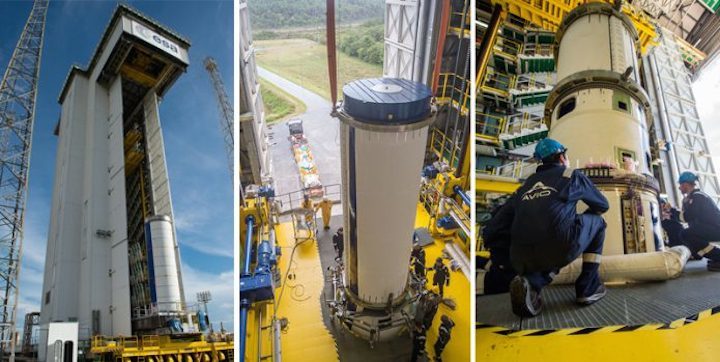
Vega assembly activity for Arianespace’s Flight VV10 is highlighted in these images from the Spaceport, beginning with the P80 first stage’s positioning at the SLV launch site (photo at left). The Zefiro 23 second stage was then installed atop the P80 first stage (center photo), followed by integration of the Zefiro 9 third stage (at right) and the AVUM (not shown).
The lightweight Vega launcher for Arianespace’s upcoming mission is undergoing final checkout in French Guiana, readying it to receive a dual payload of Earth observation satellites – consisting of OPTSAT-3000 (as the upper passenger) and Venµs (in the lower passenger position).
Vega was integrated at the Spaceport’s SLV launch site, bringing together the solid propellant P80 first stage, Zefiro 23 second stage and Zefiro 9 third stage; followed by the liquid bipropellant fourth stage, called the AVUM (Attitude and Vernier Upper Module).
The August 1 mission is designated Flight VV10 in Arianespace’s launcher family numbering system, and it will mark Vega’s 10th launch since the 2012 start-up of operations with this vehicle – all of which were successfully performed from French Guiana.
As the smallest member in Arianespace’s launcher family operated at the Spaceport, Vega complements the company’s medium-lift Soyuz and heavyweight Ariane 5 in offering a full range of launch service capabilities.
A pair of passengers for Vega
Both satellite passengers on Flight VV10 – Venµs, developed in a joint project of the Israel Space Agency (ISA) and the French CNES space agency; along with OPTSAT-3000 for the Italian Ministry of Defense – will be delivered by Vega to Sun-synchronous orbits.
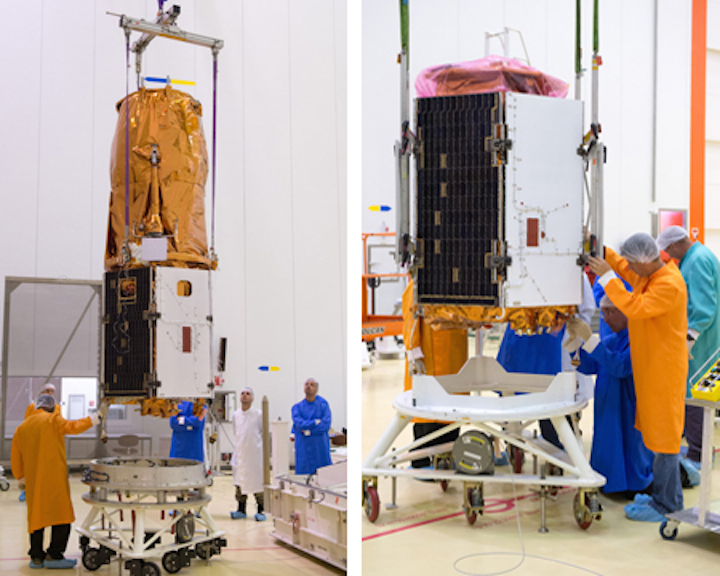
OPTSAT-3000 and Venµs (left and right, respectively) are shown during their separate checkout processes, both of which were performed inside the Spaceport’s S1 payload preparation facility.
Venµs (for Vegetation and Environment monitoring on a New MicroSatellite) is designed to provide close-up and regular monitoring of vegetation on Earth’s surface. By observing plant growth and health status, the spacecraft will help scientists to determine the impacts of environmental factors, human activities and climate change on Earth’s land surfaces.
To fulfil its scientific objectives, Venµs will acquire frequent, high-resolution, multi-spectral images of over 100 sites of interest around the world. Capturing these images will be this spacecraft’s super-spectral camera, which is characterized by 12 narrow spectral bands ranging from 415 nm to 910 nm.
Both Vega payloads were built by Israel Aerospace Industries
As the first Israeli-made satellite created for environmental research purposes, Venµs was built by Israel Aerospace Industries’ (IAI) Space Division in collaboration with Elbit, which developed the telescope, and Raphael, providing the propulsion system. The camera was supplied by CNES.
The liftoff mass of Venµs is set at 264 kg. Its scientific mission will be followed by a technological mission at a lowered altitude, which will gauge the performance of IAI-developed Hall-effect thruster technology to counter a satellite’s orbital decay caused by atmospheric drag.
Flight VV10’s other passenger, the OPTSAT-3000 Earth observation satellite, will enable national defense entities to acquire and use high-resolution images from any part of the globe.
The OPTSAT-3000 system was supplied by Telespazio as prime contractor, with responsibility for supply of the entire system: from the satellite to the ground segment, launch and early operation services, the preparation and execution of operations and logistics, through to in-orbit tests and commissioning.
The satellite was built by Israel Aerospace Industries (IAI), chosen by the Italian Ministry of Defence based on inter-governmental Italian-Israeli agreements. OHB Italy is responsible for the launch services and related engineering support.
OPTSAT-3000 will have a liftoff mass set at 368 kg. and a design life of seven years.

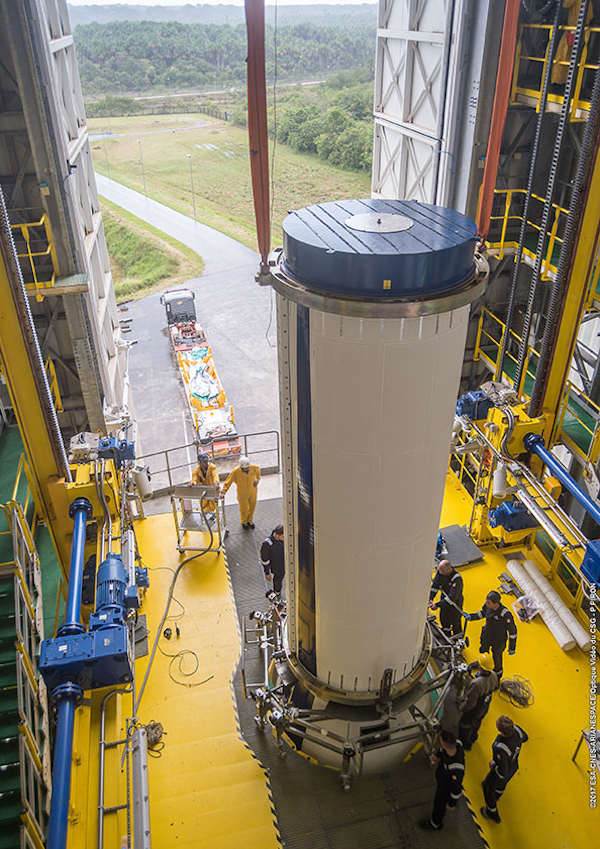
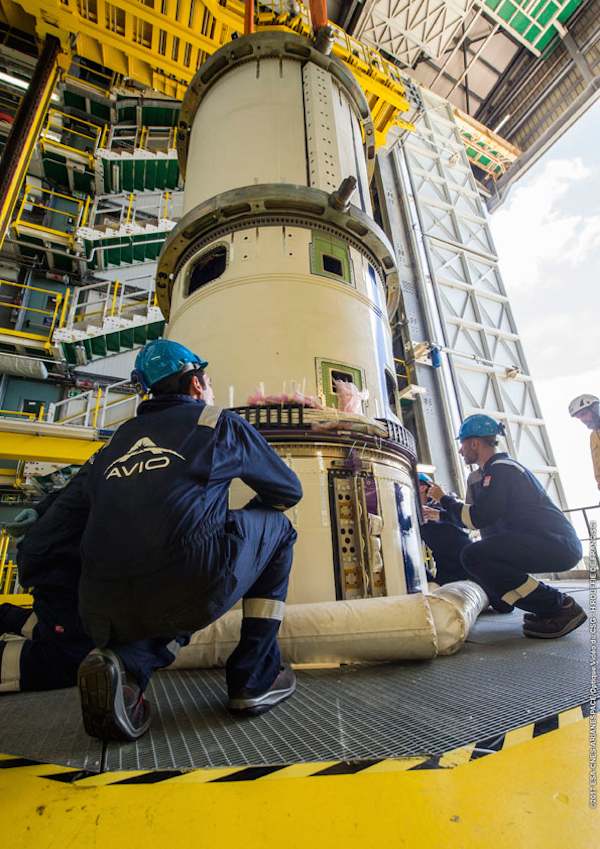
Quelle: arianespace
---
Update: 29.07.2017
.

Vega launcher set for Earth observation mission
The lightweight Vega launcher is sceduled for lift-off on 1st August carrying two Israeli-built Earth observation satellites.
The lightweight Vega launcher is set to launch a dual payload of Earth observation satellites – consisting of OPTSAT-3000 (as the upper passenger) and Venµs (in the lower passenger position).
The mission, scheduled for lift-off on 1st August, is designated Flight VV10 by Arianespace. It will mark Vega’s 10th launch since the 2012 start of operations with this vehicle – all of which have been successfully performed from French Guiana. The most recent Vega mission orbited Sentinel-2B in March.
Vega is the smallest member of the Arianespace launcher family operated at the Spaceport. It complements the company’s medium-lift Soyuz and heavyweight Ariane 5.
Both satellite passengers on Flight VV10 – Venµs, developed in a joint project of the Israel Space Agency (ISA) and the French CNES space agency, along with OPTSAT-3000 for the Italian Ministry of Defense – will be delivered by Vega to Sun-synchronous orbits.
Venµs (for Vegetation and Environment on a New MicroSatellite) is designed to provide close-up and regular monitoring of vegetation on Earth’s surface. By observing plant growth and health status, the spacecraft will help scientists to determine the impacts of environmental factors, human activities and climate change on Earth’s land surfaces.
To fulfil its scientific objectives, Venµs will acquire frequent, high-resolution, multi-spectral images of over 100 sites of interest around the world. Capturing these images will be this spacecraft’s super-spectral camera, which is characterized by 12 narrow spectral bands ranging from 415nm to 910nm.
Venµs — the first Israeli-made satellite created for environmental research purposes —was built by Israel Aerospace Industries’ (IAI) Space Division in collaboration with Elbit, which developed the telescope, and Raphael, providing the propulsion system. The camera was supplied by CNES.
The liftoff mass of Venµs is 264kg. Its scientific mission will be followed by a technological mission at a lowered altitude, which will gauge the performance of IAI-developed Hall-effect thruster technology to counter a satellite’s orbital decay caused by atmospheric drag.
Flight VV10’s other passenger, the OPTSAT-3000 Earth observation satellite, will enable national defense entities to acquire and use high-resolution images from any part of the globe.
The OPTSAT-3000 system was supplied by Telespazio as prime contractor, with responsibility for supply of the entire system: from the satellite to the ground segment, launch and early operation services, the preparation and execution of operations and logistics, through to in-orbit tests and commissioning.
The satellite was built by Israel Aerospace Industries (IAI), chosen by the Italian Ministry of Defence based on inter-governmental Italian-Israeli agreements. OHB Italy is responsible for launch services and related engineering support.
OPTSAT-3000 will have a liftoff mass of 368kg and a design life of seven years.
Quelle: Air&Cosmos
---
Update: 29.07.2017
Vega receives its OPTSAT-3000 and Venµs payloads for Arianespace’s August 1 mission
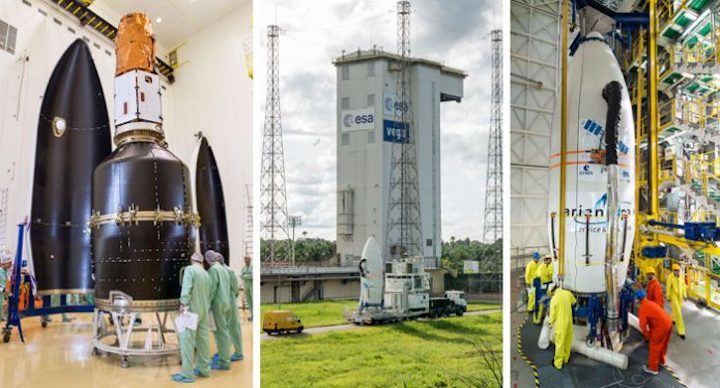
Vega’s completion is highlighted in this photo series, beginning with encapsulation of the two satellite passengers – OPTSAT-3000 and Venµs – inside their protective payload fairing (photo at left). This component – called the “upper composite” – was then moved from the Spaceport’s S3B facility to the SLV launch site on a special transporter (center), hoisted to the appropriate level of the mobile gantry, then integrated with the light-lift vehicle (right).
Build-up of the lightweight Vega for Arianespace’s upcoming mission to orbit twin Earth observation satellites is complete in French Guiana, with the OPTSAT-3000 and Venµs spacecraft now integrated with their launch vehicle.
During activity on the Spaceport’s SLV launch site, the two passengers – which are integrated in their payload fairing – were installed on Vega, topping off the vehicle composed of three solid-propellant stages and a liquid bipropellant upper stage.
Vega will now undergo final preparations and checkout leading to a nighttime liftoff on August 1 (local time in French Guiana) for Arianespace Flight VV10, marking the 10th mission for this vehicle since its 2012 service entry.
As the smallest member in Arianespace’s launcher family, Vega complements the company’s medium-lift Soyuz and heavyweight Ariane 5 in providing a full range of launch services for customers worldwide. ELV/Avio is the vehicle’s production prime contractor.
OPTSAT-3000 to be deployed first by Vega
To be deployed first during the mission to Sun-synchronous orbit is OPTSAT-3000 – an Earth observation satellite for the Italian Ministry of Defense. Built by Israel Aerospace Industries (IAI) based on inter-governmental Italian-Israeli agreements, it will enable national defense entities to acquire and use high-resolution images from any part of the globe.
The OPTSAT-3000 system was supplied by Telespazio as prime contractor, which has responsibility for the entire system: from the satellite to the ground segment, launch and early operation services, the preparation and execution of operations and logistics, through to in-orbit tests and commissioning. OHB Italia is responsible for the launch services and related engineering support.
With a design life exceeding seven years, OPTSAT-3000 has a liftoff mass of 368 kg.
Venµs puts the focus on Earth vegetation
Riding in the lower payload position on Vega is Venµs, an Earth observation and exploratory mission for the Israeli Space Agency (ISA) and France’s CNES space agency at the benefit of the Israeli Ministry of Science & Technology.
As the first Israeli-made satellite created for environmental research purposes, Venµs was developed by Israel Aerospace Industries’ Space Division, with Rafael providing the propulsion system. The spacecraft has a liftoff mass set at 264 kg.
CNES is in charge of the multi-spectral camera, its image programming and processing, as well as the distributing ground station, with the camera’s development performed for CNES by Elbit Electro-Optic Systems Elop Ltd.
Venµs – which is the acronym for “Vegetation and Environment on a New Micro Satellite” – will study the evolution of the Earth’s vegetation during its scientific mission, while the satellite’s technological mission will provide in-flight qualification of the Israeli Electrical Propulsion System, based on Hall-Effect thrusters.
Flight VV10 will be Arianespace’s eighth mission of 2017. It follows the launches of four Ariane 5s, two Soyuz vehicles and one Vega so far this year.
- Larger versions of the photos above are available for downloading in the Gallery.
Launch timing for Flight VV10:
| French Guiana | Washington, D.C. | Universal Time (UTC) | Paris | Rome |
| 10:58:33 p.m. on Aug. 1 |
9:58:33 p.m. on Aug. 1 |
1:58:33 on Aug. 2 |
3:58:33 a.m. on Aug. 2 |
3:58:33 a.m. on Aug. 2 |
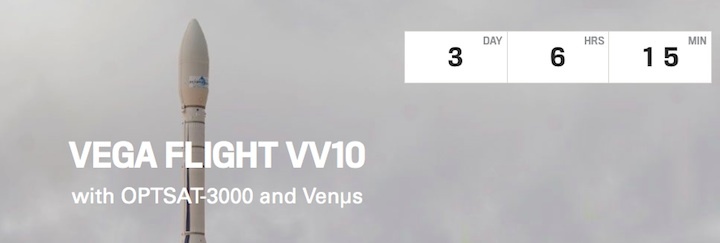
Quelle: arianespace
---
Update: 31.07.2017 / 8.10 MESZ
-
Flight VV10: Vega to launch Earth Observation Satellites for Italy, France and Israel
For its eighth launch of the year, and the 10th Vega mission since this launcher began its career at the Guiana Space Center in 2012, Arianespace will orbit OPTSAT-3000 and Venµs – two Earth observation satellites for civil and military applications.
This marks the seventh Earth observation mission for Vega, a light launcher now in full commercial operation, whose versatility has been largely proven during its nine previous missions – all successful.
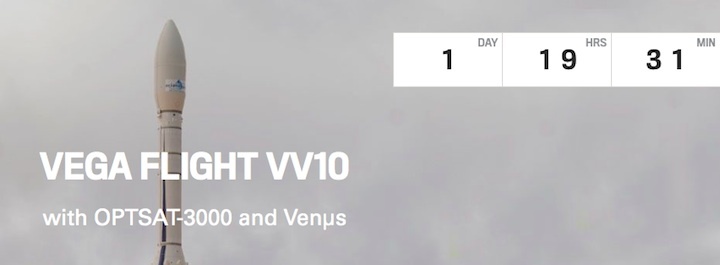
---
Update: 2.08.2017
.
Erfolgreicher Start von Vega VV10 - LIVE-Frams:
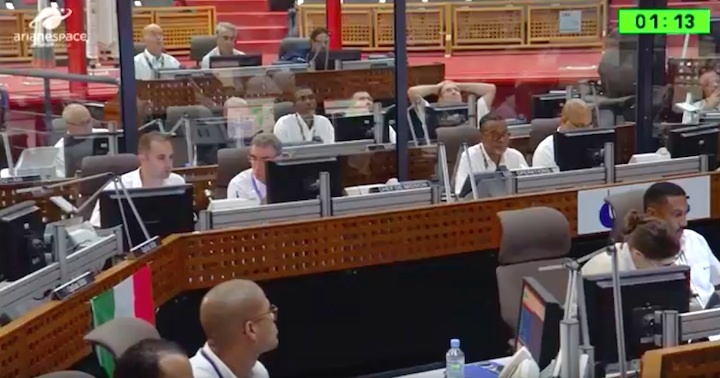
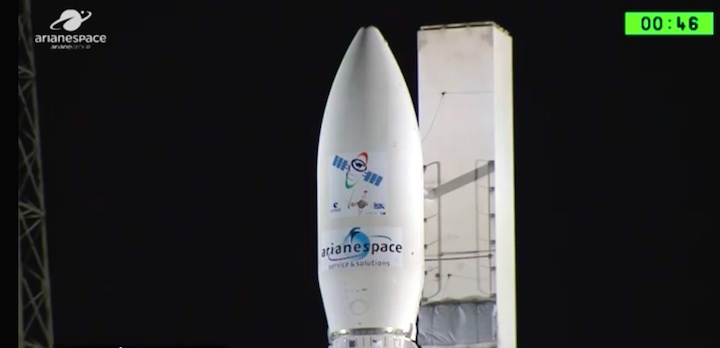
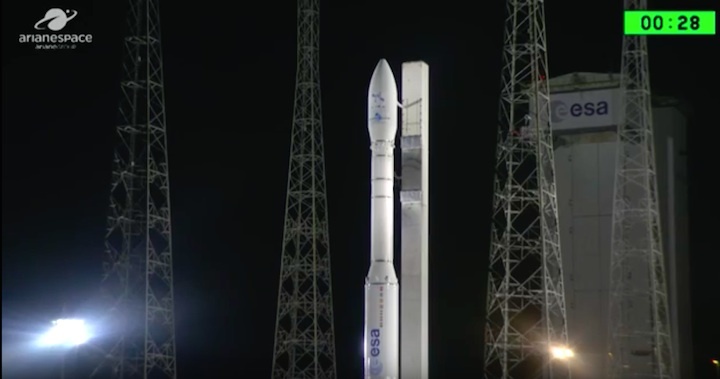
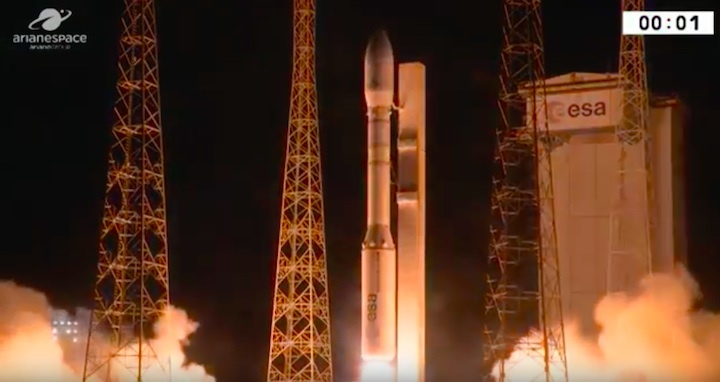

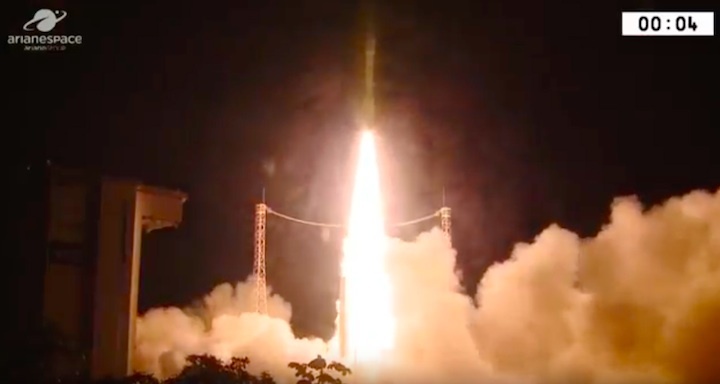
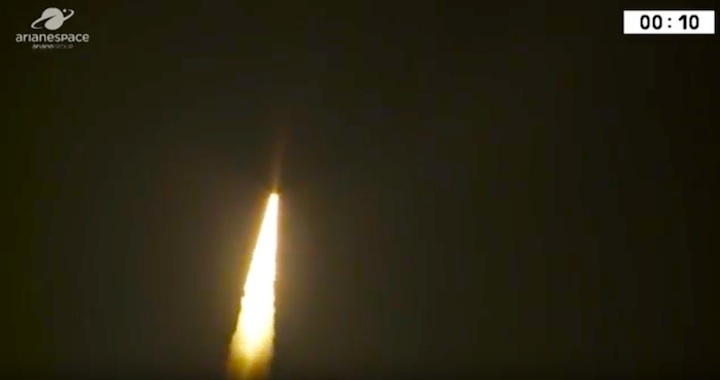
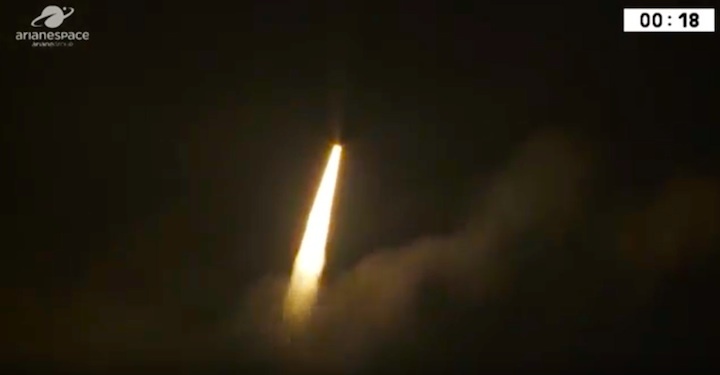

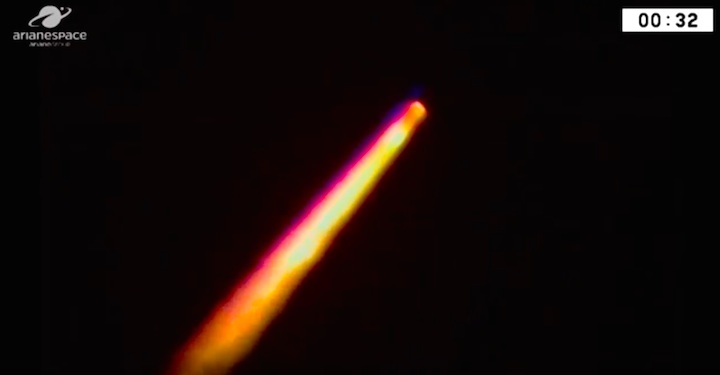
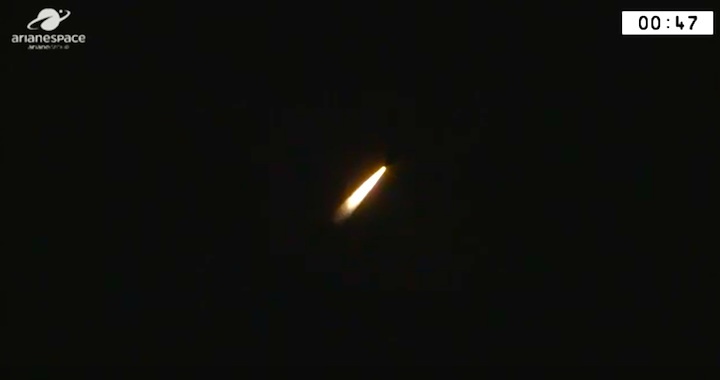
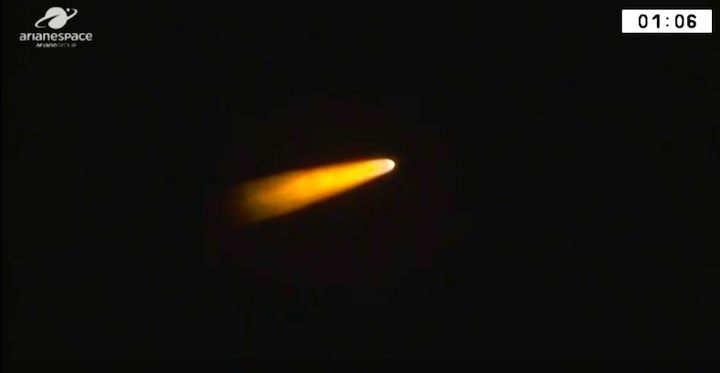
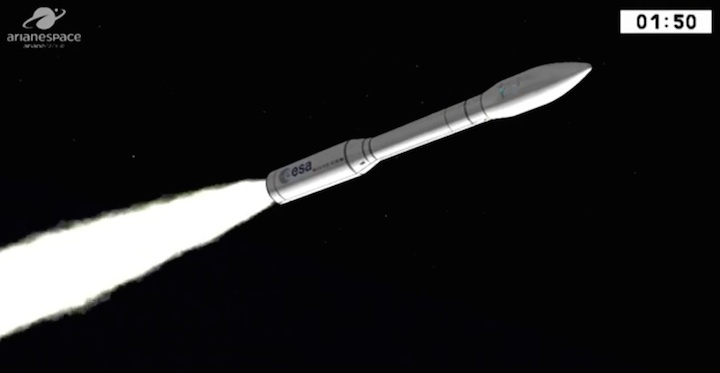
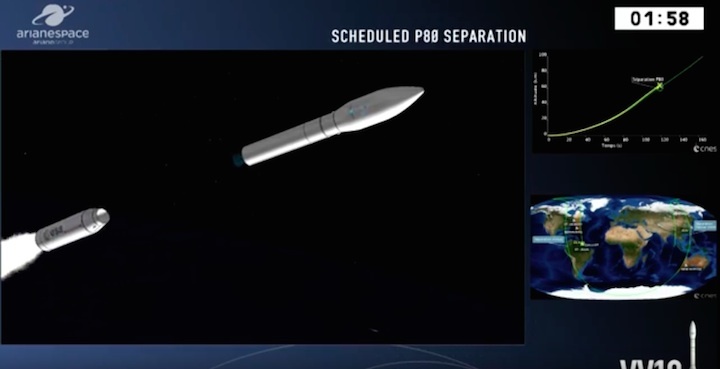
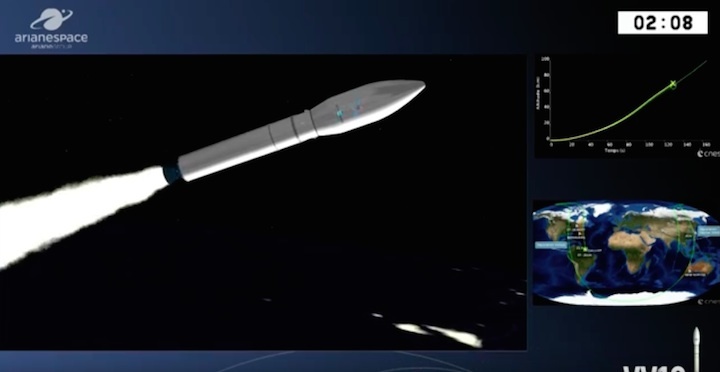
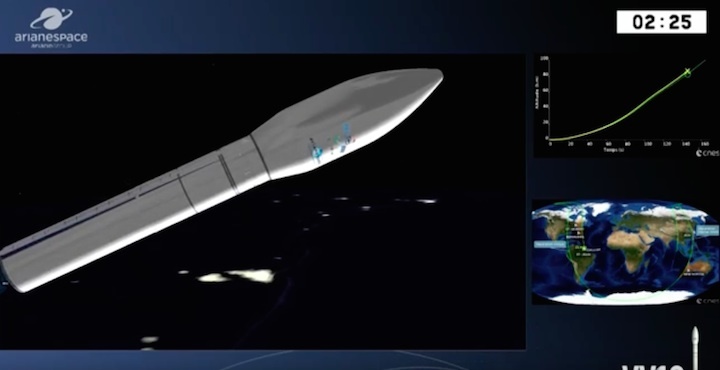
Quelle: arianespace
+++
Israel Launches Its First Environmental Research Satellite
Data provided by the satellite will provide policy makers and businesses involved in agriculture information on what to grow and where
The first Israeli satellite for environmental research was launched early Wednesday morning from the European spaceport in Kourou,...
---
Update: 3.08.2017
.
A perfect “10” – Arianespace’s lightweight Vega orbits OPTSAT-3000 and Venµs on a milestone success
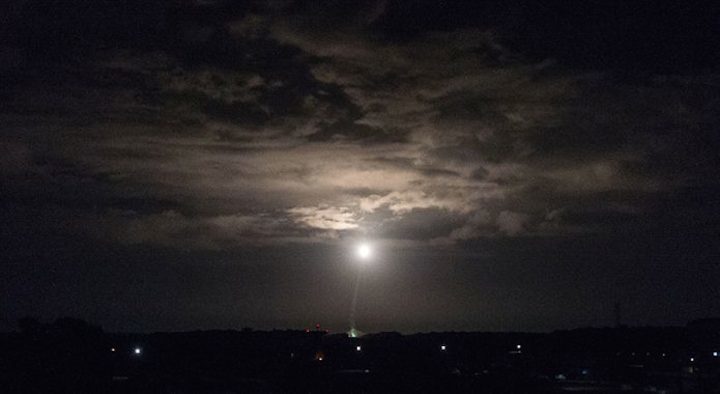
The light-lift Vega ascends from the Spaceport's SLV launch complex with its OPTSAT-3000 and Venµs satellite passengers.
For the second time this year – and the 10th overall since entering service in 2012 – Vega has successfully launched a payload from the Spaceport, with this lightweight vehicle’s latest mission delivering the OPTSAT-3000 and Venµs Earth observation satellites to Sun-synchronous orbits.
Lifting off from the Spaceport’s SLV launch complex at precisely 10:58:33 p.m. French Guiana time on August 1, Vega lofted its multi-passenger payload during a flight sequence lasting 1 hour, 37 minutes.
Speaking from the Spaceport’s Jupiter control room, Arianespace Chief Executive Officer Stéphane Israël declared the launch a success and reflected on Vega’s new “10-for-10” operational record, which includes four of these successes achieved during the past 11 months.
He added: “In five years of activity, our lightweight vehicle already has orbited a total of 25 satellites for 19 customers worldwide, both institutional and commercial, serving a wide range of space applications, such as Earth observation, science, technology and education.”
Delivering OPTSAT-3000 for Italy
During the initial phase of the mission – designated Flight VV10 in Arianespace’s launcher family numbering system – Vega was powered by its three solid propellant stages, which was followed by multiple burns of the bi-propellant upper stage, before separate deployments of the two spacecraft.

Lighting up the launch pad at liftoff, Vega begins its flight sequence lasting a little more than an hour and a half.
The first passenger released by Vega, OPTSAT-3000, is an Earth observation satellite for the Italian Ministry of Defence. It was built by Israel Aerospace Industries (IAI) based on inter-governmental Italian-Israeli agreements, and once operational, will enable national defense entities to acquire and use high-resolution imagery from any part of the globe.
The OPTSAT-3000 system was supplied by Telespazio as prime contractor, which has responsibility for the entire system; while OHB Italia was responsible for the launch services and related engineering support.
Stéphane Israël congratulated all the partners involved with OPTSAT-3000, and gave special thanks to the Italian Ministry of Defence, adding: “We are very proud to have delivered for Italy with our most Italian launcher, Vega.”
General Enzo Vecciarelli, Chief of Staff of the Italian Air Force, acknowledged the “superb capabilities of a great team” that was responsible for OPTSAT-3000’s development and launch. In comments at the Spaceport’s control center, he noted it marks another step forward in European cooperation in space, “which is something that we really need, because we live in a critical time for the security and stability environment – where there is a lack of situational awareness.”
Venµs: an Israeli-French collaboration
The second passenger orbited on Flight VV10 – Venµs, also produced by Israel Aerospace Industries — is an Earth observation and exploratory mission for the Israel Space Agency (ISA) and France’s CNES space agency at the benefit of Israel’s Ministry of Science, Technology and Space.
Venµs (an acronym for “Vegetation and Environment monitoring on a New Micro Satellite”) will study the evolution of Earth’s vegetation during its scientific mission, while the satellite’s technological mission will provide in-flight qualification of the Israeli electrical propulsion system, based on Hall-Effect thrusters. CNES is in charge of the multi-spectral camera, its image programming and processing, as well as the distributing ground station; while the camera’s development was performed for CNES by Elbit Electro-Optic Systems, Elop Ltd.
Arianespace’s CEO welcomed and thanked the leaders from Israel and France’s space agencies in attendance for the launch, and added that he hopes this flight serves as a benchmark for further ambitious space cooperation between Israel and France.
Peretz Vazan, Director General of Israel’s Ministry of Science, Technology and Space, called the launch a “spectacular event,” and provided his “mazel tov” (congratulations, in Hebrew) to all involved in the success.
An eye on the future
In addition to bringing Vega’s tally of successes to double-digits, Flight VV10 also marked its first launch under a new operational organization between Arianespace and the vehicle’s production prime contractor, Italy’s Avio.

The payload fairing, which encapsulated Flight VV10’s two satellite passengers during Vega’s ascent through the denser layers of Earth’s atmosphere, was manufactured using a new “out of autoclave” production process.
Under the new arrangement aimed at enhancing competitiveness, Avio now assumes responsibility for preparing the launcher until liftoff; while Arianespace maintains full responsibility for customer relations, as well as operations for the final countdown and launch decision.
Reinforcing Arianespace’s continued focus on innovation, Flight VV10’s Vega also utilized a new “out of autoclave” payload fairing that was developed by RUAG for the next-generation Vega C launcher, with the manufacturing process also to be applied to payload fairings for the follow-on Ariane 6 heavy-lift vehicle.
Flight VV10 continues Arianespace’s busy schedule in 2017, in which eight launches were performed during the year’s first seven months utilizing the company’s family of launchers (two with the lightweight Vega; two with the medium-lift Soyuz; and four using the heavy-lift Ariane 5).
The company’s next mission is scheduled for early September, when Ariane 5 will lift off from French Guiana on a flight to geostationary transfer orbit with a pair of relay satellites: Intelsat 37e and BSAT-4a.
Quelle: arianespace

